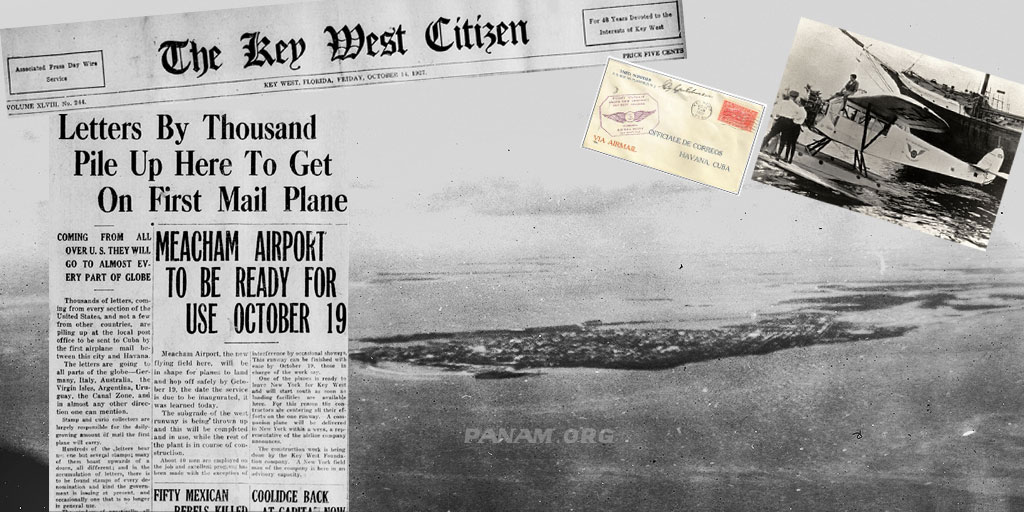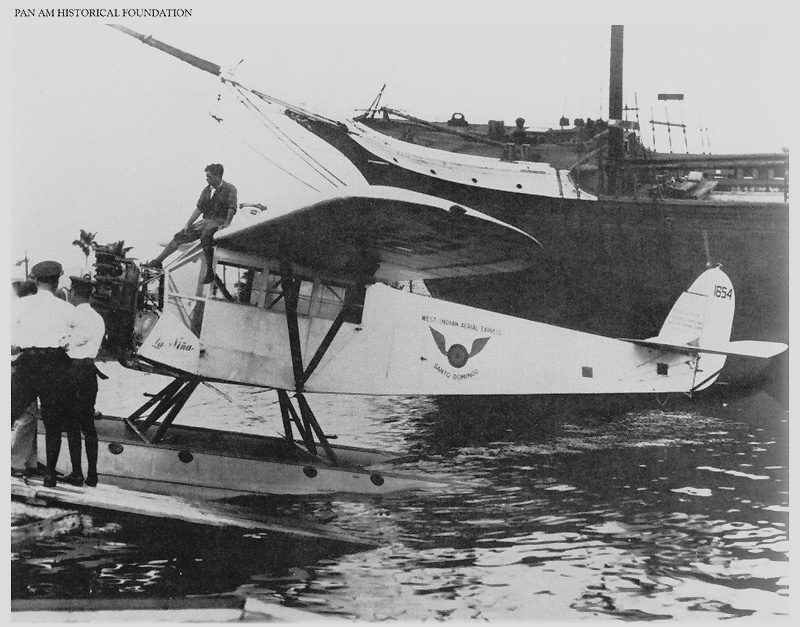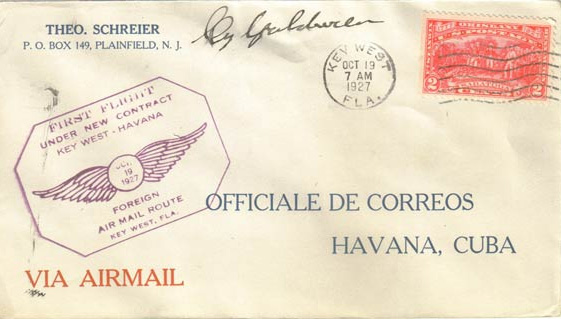Preparations for Pan Am's Big Day

Anticipation and excitement had been building for days in Key West, as evidenced by the "Key West Citizen" headline on October 14th, 1927.
Courtesy of Key West Library (Monroe County Public Library, Florida Keys)
A new fledgling airline named Pan American Airways was going to start up America’s new foreign airmail contract route to Cuba, and letters by the thousands had been pouring in to be postmarked and carried to Havana. Airmail was new and exciting, and airmail to another country was a really big deal. After all, it was only five months since Charles Lindbergh had flown the Atlantic!
But the US Post Office had made it clear that October 19th was the deadline for fulfillment of the contract’s commencement. If Pan Am failed to honor the deal, the contract could well be voided, and the tentative enterprise that Juan Trippe, John Hambleton and their small group of associates had been planning and working to create might come apart at the seams.
Down in Key West, the patch of open ground near the old fort, given the aspirational name of Meacham Field, was a mess. Days of manual labor to move rocks and fill holes had come undone thanks to a heavy rain. The new Fokker F-VII that Ed Musick had only just ferried down to Florida from Tony Fokker’s factory in New Jersey sat in Miami, with no place to land in Key West.
All the excitement, hopes, and big plans hung by a thread. But fate was on Pan Am’s side that October.
Jack “Pink Whiskers” Whitbeck was Pan Am’s manager on the scene in Florida, in charge of preparations for the new airline’s start. Jack had come from the US Post Office’s Air Mail service, and had brought along another former Post Office employee Fred Gelhaus to work for Pan Am. With a local crew that included Charles “Gunner” Morgan they had been battling the elements in Key West to prepare the air field.
When he got wind of a Fairchild FC-2 on floats being ferried through Miami on the way to it’s new owner, West Indian Aerial Express in the Dominican Republic, Whitbeck wasted no time. The pilot, Canadian Cy Caldwell had been delayed in Miami by an oil leak. The delay was enough to give Whitbeck time to proposition Caldwell with the offer of a quick cash payment of perhaps $150 (the actual amount has always been a matter of conjecture) to carry Pan Am’s mail load on his way south. The deal was struck, and Caldwell was there at Key West on the morning of October 19th, ready to receive the 30,000 letters that had accumulated for the flight to Havana.
The quick trip of ninety miles took about an hour, and began a 64-year run of commercial aviation pioneering and progress for Pan American Airways.
It all came down to the wire on this day in 1927.

On her way to Key West for the Inaugural Flight: La Niña in Miami, October 15, 1927
Meeting the October 19th, 1927 Deadline.
The coveted U.S. Post Office contract for the Foreign Airmail Contract to carry the U.S. Mail from Key West Florida to Havana Cuba – and the great potential for expansion of air routes beyond to Latin America – lay in the balance.
The immediate concern was a $25,000 cash bond deposited as a guarantee of performance – as well as the possible withdrawal of the contract – that depended on the successful completion of the first airmail flight, which had to be completed by October 19th, 1927.
The trail leading up to this historic moment had been fraught with political and business intrigue, as well as high-stakes financial maneuverings by rival groups of powerful and ambitious players. The ultimate prize was the airmail contract.
Three groups had played an intricate game, trying to outmaneuver one another to gain the ultimate advantage. Juan Trippe, a twenty-seven year-old former bond salesman and recently dismissed airline executive had spearheaded one group incorporated as The Aviation Corporation of America. Another group, Pan American Airways, had been the brainchild of four American military officers, of whom only U.S. Navy Captain J.K. Montgomery remained, but he had enlisted some very influential and wealthy backers. The third player in this drama was another (also well-funded) group organized around World War One ace Eddie Rickenbacker and his by-now-bankrupt airline, Florida Airways.
On July 16th, the Post Office awarded the contract to carry U.S. mail to Havana to Pan American Airways. What they did not have was the right to land in Cuba! As it happened – perhaps guided by some almost clairvoyant hunch – Juan Trippe had negotiated that very permission from the Cuban government months earlier, when he flew to Havana with aircraft builder Tony Fokker on a demonstration flight. That proved to be the ultimate trump card.
The wrangling between the three groups continued on through the summer, and the early fall of 1927. In an almost operatic succession of events, with just over one week left till the Post Office’s deadline to fly the first mail to Havana, a solution was found. The three groups would re-align under the aegis of a new entity – Atlantic, Gulf, and Caribbean Airways.

Envelope carried on Key West to Havana flight Oct. 19th, 1927
First flight cover: Jeff Staines Courtesy http://www.dmairfield.com
The next problem to solve was of a much more practical nature. Trippe had ordered two aircraft – both Fokker F-VII tri-motors, and they were enroute to Key West. The problem was that they had no place to land there. A crew had been working furiously to prepare a suitable airport at Key West, but they were stymied in attempts to fill holes in the soft coral soil at the chosen site.
In an almost miraculous coincidence of events, it happened that two aircraft including a Fairchild FC-2 floatplane, christened La Niña, were being ferried through Miami on their way to their new home, a small airline in Santo Domingo known as West Indian Aerial Express (W.I.A.X.), at just that moment. Very fortunately for the new Pan Am, Basil Rowe, the owner of W.I.A.X. was flying one of the aircraft and agreed to the suggestion that he permit the charter of the Fairchild to carry Pan Am’s mail to Havana.
And so it was that on the very last day permitted under the U.S. Post Office contract, a (chartered) Pan American Airways aircraft, flown by Cy Caldwell (a Canadian citizen) operated Pan Am’s very first flight.



